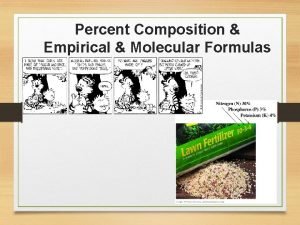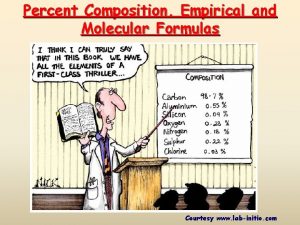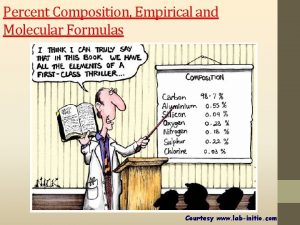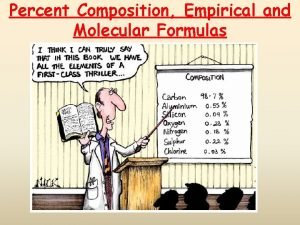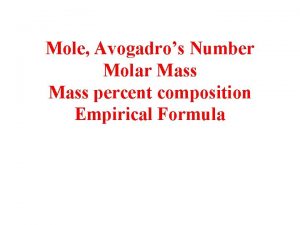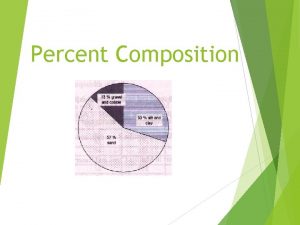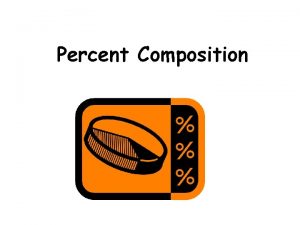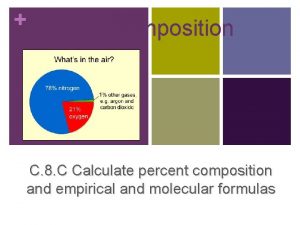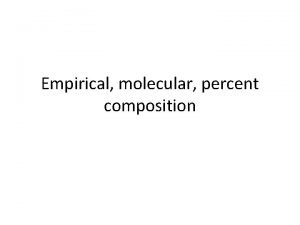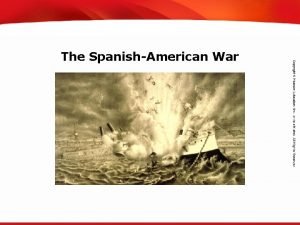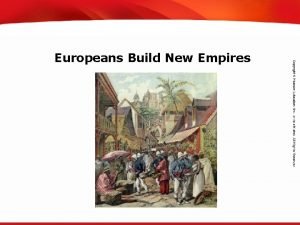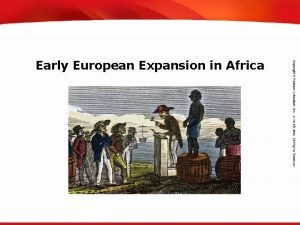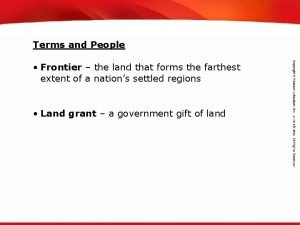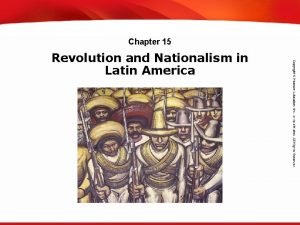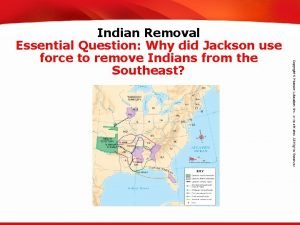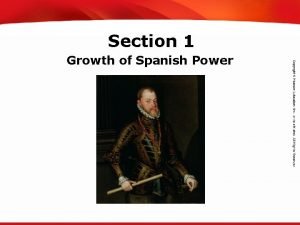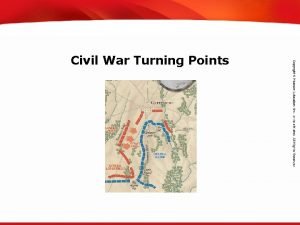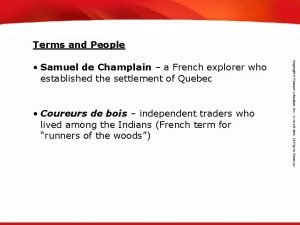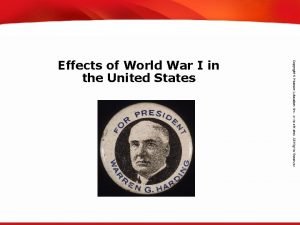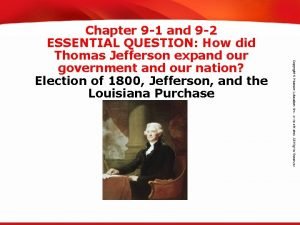TEKS 8 C Calculate percent composition and empirical
















- Slides: 16

TEKS 8 C: Calculate percent composition and empirical and molecular formulas. Jackson Era 2

TEKS 8 C: Calculate percent composition and empirical and molecular formulas. Objectives • Evaluate the significance of the debate over tariffs and the idea of nullification. • Summarize the key events of the conflict over the second Bank of the United States in the 1830 s. • Analyze the political environment in the United States after Andrew Jackson.

TEKS 8 C: Calculate percent composition and empirical and molecular formulas. Terms and People • Tariff of Abominations – name that opponents from the agricultural south gave to the high protective tariff of 1828 • John C. Calhoun – vice president who resigned to lead South Carolina’s fight over nullification in the Senate • nullification – concept that a state could void a federal law that it deemed unconstitutional

TEKS 8 C: Calculate percent composition and empirical and molecular formulas. Terms and People (continued) • Whig – member of a political party formed in the 1830 s, favored a strong federal government, protective tariffs, a national bank, and internal improvements

TEKS 8 C: Calculate percent composition and empirical and molecular formulas. What major political issues emerged during the 1830 s? Conflicts and crises that arose during Jackson’s presidency led to the formation of a rival political party called the Whigs. In spite of this, Jackson’s handpicked successor, Martin Van Buren, won in 1836 but lost to the Whigs in 1840.

TEKS 8 C: Calculate percent composition and empirical and molecular formulas. • In 1828, Congress Tariffs were a continuing source of dispute between the industrial North (favored) and agricultural South (opposed). passed a high protective tariff. • The goal was to promote industry, but the tariff raised the prices farmers had to pay for goods. • Southerners called it the Tariff of Abominations.

TEKS 8 C: Calculate percent composition and empirical and molecular formulas. In 1832, South Carolina voted to nullify the tariff. The state threatened to secede from the Union if the federal government used force to collect the tariffs. • Vice President John C. Calhoun expected Jackson to reject the tariff. Instead, Jackson modified it only slightly. • In protest, Calhoun resigned as Vice President to lead the nullification battle in the Senate.

TEKS 8 C: Calculate percent composition and empirical and molecular formulas. Resolution of the Nullification Crisis of 1833 Jackson, a Democrat, normally supported southern states, but he strongly rejected this challenge to his authority and to the Union. Economic nationalists such as Daniel Webster rejected the concept of nullification. Congress passed a Force Bill that authorized troops to enforce collection. In a compromise, Congress lowered the tariff. The issues of nullification and secession were left unresolved.

TEKS 8 C: Calculate percent composition and empirical and molecular formulas. Despite his opposition to nullification, Jackson generally supported the agricultural South. • His ideal was an agrarian republic in which almost all white men owned farms and enjoyed a rough equality. • Industrialization and the growing class of wage earning factory workers made his ideal unrealistic. • The expanding gap between rich factory owners and poor workers became troubling to many Americans.

TEKS 8 C: Calculate percent composition and empirical and molecular formulas. The second Bank of the United States divided Americans. Jacksonian Democrats • Felt the second Bank symbolized “money power. ” • Believed the new business economy encouraged corruption. • Opposed policies they felt enriched business at the expense of farmers and workers. Business Leaders • Believed the second Bank was necessary to maintain a stable supply of currency.

TEKS 8 C: Calculate percent composition and empirical and molecular formulas. • In 1832, Congress voted to renew the Bank’s charter. • Jackson vetoed the charter renewal. • The “Bank War” strengthened Jackson’s popularity with ordinary Americans and helped him win reelection in 1832. This cartoon shows Jackson using a veto to slay a monster representing the Bank and its supporters.

TEKS 8 C: Calculate percent composition and empirical and molecular formulas. Presidential vetoes were rare. Bank supporters denounced Jackson as a power-hungry tyrant and formed a new political party, the Whigs. The Whigs were led by Daniel Webster of Massachusetts and Henry Clay of Kentucky. Whigs favored a strong federal government, broad interpretation of the Constitution, protective tariffs, internal improvements, and moral reform.

TEKS 8 C: Calculate percent composition and empirical and molecular formulas. • Martin Van Buren of New Jackson’s economic policies led to disaster for the next president. York, Jackson’s handpicked successor, won the election of 1836. • With no federal banks, state banks flooded the market with currency, causing extreme inflation. • The government stopped accepting paper money for land purchases, leading to a sudden drop in land values.

TEKS 8 C: Calculate percent composition and empirical and molecular formulas. The resulting Panic of 1837 became the worst depression the nation had yet experienced. • Inflation caused by the state banks hurt common people. • The drop in land values led to bankruptcies. Many planters and farmers lost their land. • A third of urban workers lost their jobs, and wages dropped by 30 percent. The Panic hurt Van Buren and the Democratic Party.

TEKS 8 C: Calculate percent composition and empirical and molecular formulas. In 1840, the Whigs nominated William Henry Harrison and John Tyler. • Harrison was portrayed as a simple farmer, born in a log cabin, while Van Buren was painted as an ineffective, corrupt aristocrat. • The slogan “Tippecanoe and Tyler Too” reminded voters of Harrison’s military record. Harrison’s victorious 1840 campaign focused on symbols like his log cabin background, seen in this flag.

TEKS 8 C: Calculate percent composition and empirical and molecular formulas. One month after his inauguration, President Harrison died of pneumonia. • Vice President John Tyler assumed the Presidency and, to the dismay of the Whigs, rejected their policies. • Tyler vetoed legislation to restore the Bank of the United States and to enact Clay’s American System.
 How to find molecular formula
How to find molecular formula What is the acid found in soft drinks ?
What is the acid found in soft drinks ? How to find molecular formula
How to find molecular formula How to find empirical formula from percent
How to find empirical formula from percent Courtesy formulas
Courtesy formulas Empirical formula with percentages
Empirical formula with percentages How to find empirical formula with percentages
How to find empirical formula with percentages How to calculate empirical formula from percentages
How to calculate empirical formula from percentages Percent composition of propane
Percent composition of propane How to calculate percent composition by mass
How to calculate percent composition by mass Percent composition examples
Percent composition examples How to calculate valid percent
How to calculate valid percent Percent composition bubble gum lab answer key
Percent composition bubble gum lab answer key Water percentage composition
Water percentage composition Percent composition definition
Percent composition definition Percent by mass
Percent by mass Percent composition
Percent composition

